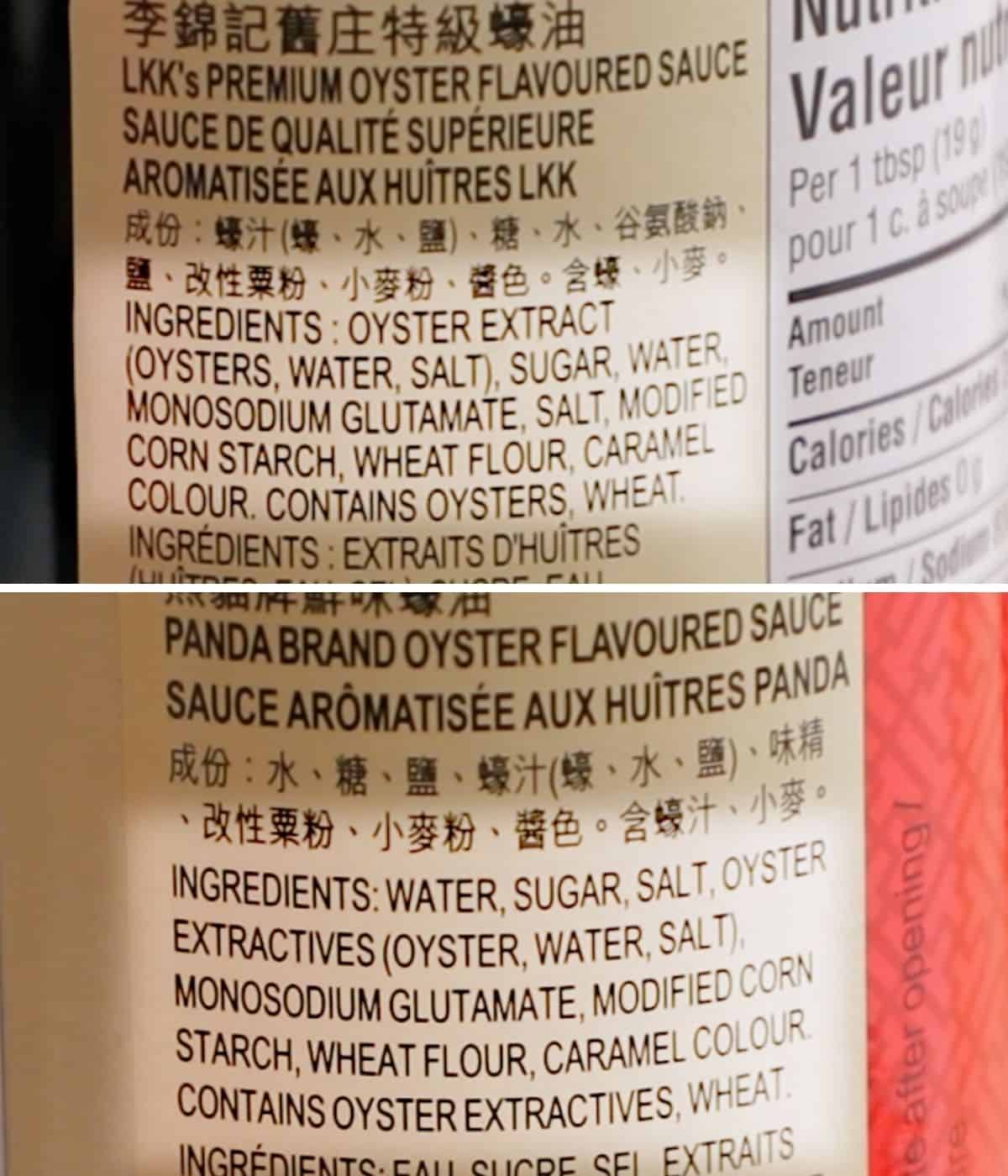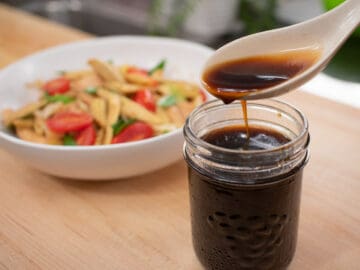What is Oyster Sauce And Which is the Best One?
If you love cooking Asian food, oyster sauce is probably already in your kitchen. But do you know if the one you have is a "good one”? And is the expensive oyster sauce you bought (or didn't buy) worth the splurge?
This post will discuss everything you need to know about oyster sauce, including what it is, how to use it, and which brand is the best after tasting them straight up and in a stir fry! To see the oyster sauce taste test in action, complete with my reaction and full analysis, be sure to watch the video !

What is oyster sauce and what does it taste like?
Oyster sauce is a predominantly salty seasoning that is most commonly used in stir fries, but is also used in stews, soups, marinades, and even straight up as a drizzle over steamed vegetables. Thick, rich, salty, umami and slightly sweet are the characteristics of oyster sauce, and it won’t necessarily make you go, “wow, oysters!”
In Thai cuisine, it’s a member of what I call "the trinity of Thai sauces.” Along with soy sauce and fish sauce , it’s a staple in every Thai kitchen, and many people use it daily.
The Origin Story
Oyster sauce is of Chinese origin, but is now used in many Southeast Asian countries where their cuisines have been influenced by China. Lee Kum Sheung, the founder of the popular oyster sauce brand Lee Kum Kee , is said to have accidentally invented oyster sauce in 1888.
The story goes that Lee Kum Sheung forgot about a simmering pot of oyster soup, and when he came back to it, it had reduced into a thick, rich, brown liquid. He discovered that this liquid was flavourful and tasty, and that was the beginning of oyster sauce. A note: this story is told by Lee Kum Kee themselves in this video.
How is oyster sauce made?
If you had to guess how oyster sauce was made, you might have reasonably thought that there are pureed oysters in it, which is why it’s thick. Nope.
Or you might have thought that if soy sauce is made from fermented soy beans, fish sauce from fermented fish, and shrimp paste from fermented shrimp, then oyster sauce must be made from fermented oysters! Also no.
Surprisingly there are no actual oysters in oyster sauce at all , but there are “oyster extracts.” Oyster extract is basically oyster cooking liquid, as per the origin story. Shucked oysters are boiled in big vats, then the oysters are removed, and the remaining briny, flavourful liquid is the base of oyster sauce.

The oyster extract may get further reduced, then starch is usually added to thicken, and other seasonings are added such as salt, sugar, soy sauce, MSG and colouring. Brands vary significantly in what seasonings they choose to add, and in my video taste test I was so surprised at how different they taste; especially when comparing the Thai and Chinese versions!
Oyster Sauce Taste Test: Which brand is best, and does it really make a difference?
I bought 4 brands of oyster sauce that I can find here in Vancouver and pitted them against each other. So here they are - and watch the video below to find out how they perform when tasted straight up, and whether the difference is really that obvious once used in a stir fry!
- Lee Kum Kee Premium - Or what I call the “Boat Lady” brand as per the label. This is the premium and original oyster sauce from LKK, and in Vancouver a bottle costs about $8.
- Panda Brand (by LKK) - The most widely available oyster sauce, and probably the one your local Thai and Chinese restaurants use. This is the newer, cheaper line of oyster sauce by LKK. A bottle costs about $4 in Vancouver.
- Maekrua - The most popular Thai brand of oyster sauce. When you say “oyster sauce,” the woman on the label is the image that comes to mind for most Thai people (at least ones from my generation and older!) It costs slightly more than Panda, but not as much as Boat Lady. Maekrua is harder to find around here, and is usually available only in stores that carry a lot of Southeast Asian products.
- Healthy Boy - Healthy Boy is most famous for their soy sauces, and indeed they make my favourite soy sauces, but they have started producing all sorts of sauces in recent years. Like Maekrua, it’s not as widely available here as LKK brands. It's the least expensive of all four.
- Wish I had tried: Megachef. A new kid on the block from Thailand who has quickly gained popularity, sadly it is not available in Vancouver. I’ve heard positive reviews about their oyster sauce (and their fish sauce is great), and based on the label/ingredients it looks very promising.
VIDEO : Oyster Sauce 101 + Taste Test!
This video shows you my live side by side taste test, both straight up and also in a Chinese broccoli stir fry. Note that even though I've used these before (except Healthy Boy) this is the first time I'm tasting them side by side, so my reaction is real!
In case you don’t have time to watch the video quite yet, here’s a quick recap of my ranking:
- #1 Lee Kum Kee Premium - Boat Lady
- #2 TIED - Maekrua and Panda
- #3 Healthy Boy
How to choose the best one based on the label
So now that you know how these 4 sauces compare, but you’re at the store, and there are brands I didn’t cover here…what do you do? Well, as I shared in the video , thankfully we can still make an educated choice based on a few factors.
- Price is a good indicator of quality. Given that you are at the same store, the more expensive the brand, the more oyster extract is probably in the sauce, and the higher quality it likely is. Keep in mind that unlike fish sauce, bottle size varies significantly so you might need to do some math.
- Protein content on the nutrition label is also a good general guideline of how much oyster extract is in the bottle. But keep in mind that the serving size on the nutritional information can vary between brands, so again, be prepared for some math.

What about the ingredient list?
The ingredient list is always good to look at, and if things like MSG and added colour bother you, then you definitely want to check it out. BUT...previously I maintained that if oyster extract is listed as the first ingredient, then there must be more of it, and therefore it must taste better than a brand that has it further down the list. Makes sense, right?
Well, this proved to be not so straight forward. Here's why :
- LKK Boat Lady lists oyster extract in position #1
- Panda lists oyster extract in position #4
- Maekrua lists oyster extract in position #1
- Healthy Boy lists "oysters" in position #2
This doesn't match our taste test or the protein content in any way, EXCEPT the two LKK brands differ as expected. I'm certain that this is because the way LKK defines “oyster extract” is the same between their 2 product lines, but other brands define it differently. How concentrated and diluted is this oyster extract? We don't know. And what does "oysters" even mean in the case of Healthy Boy? We also don't know. Not to mention the cooking process and the quality of oysters...there are just too many unknowns.
So I apologize to everyone in the past whom I advised going entirely by the ingredient list!

Is oyster sauce gluten free?
Most of the time, no. Wheat flour is sometimes added as a thickener as is the case with both LKK brands, and some brands, such as Maekrua, contain soy sauce which isn't gluten free. But Panda brand does have a gluten free oyster sauce that I have seen in some stores, and Megachef (the Thai brand I couldn't find) is gluten free.
Can I use Chinese oyster sauce in Thai food?
Yes. While the flavours of Thai and Chinese oyster sauces are obviously different in a taste test, once it’s in a dish it’s close enough that it’s not going to make the dish taste inauthentic. If it makes you feel better, your local Thai restaurant is most likely using Panda.
I usually buy LKK Boat Lady because of ones that are easily accessible to me, it’s the best. But whenever I make a trip to the Thai store, I will grab a bottle of Maekrua because it’s what I grew up with, and the bottle really has a nostalgic effect on me.
However, after this taste test, I was surprised how much better Boat Lady is than Maekrua…so…this changes things. I’ll likely buy Maekrua much less now - as sad as that is!
But if you have a memory of a dish that you had in Thailand and you want it to taste exactly like what you remember, then using Maekrua is probably going to get you there.
How do you cook with oyster sauce?
I call oyster sauce “the queen of stir fry sauces” . Meat and veggie stir fries , fried rice, fried noodles …all of these are great places to use oyster sauce - and though you can use it as the only sauce in stir fries, I like to use it in combination with soy sauce and fish sauce for a more complex flavour.
You can add it to soups and stews, but because of its richness we usually use it in something a little richer such as the Thai beef stew , five spice eggs and pork belly soup , or the famous boat noodles.
It’s also perfect in meat marinades. A little salty, a little sweet, and with lots of umami, it’s a major player in the only steak marinade you need !
Finally, you can use it straight up or slightly diluted as a drizzle over steamed veggies (usually Chinese broccoli), but I highly recommend using the premium LKK oyster sauce for this. The other brands I find too salty. Case in point, in Thailand where Maekrua is our main oyster sauce, we don’t usually use it straight up.
How to Store
Once opened, oyster sauce should be kept in the fridge as it will get moldy at room temperature. However, if you go to Thailand, you’ll see most people keep their oyster sauce at room temperature despite it saying “refrigerate after opening” on the label.
This is because we use it almost daily and can go through a bottle very quickly; and with many Thai kitchens being outside, it’s just more convenient to keep all our sauces outside as well.
Vegetarian Substitutes for Oyster Sauce

If you are vegan/vegetarian or allergic to shellfish, good news! There are decent substitutes on the market, such as one I used for this vegan claypot glass noodle recipe.
While you may not find bottles labeled "vegetarian oyster sauce" or "vegan oyster sauce," you might find ones that are meant to be vegan substitutes for oyster sauce. The picture above shows two good brands labeled " vegetarian stir fry sauce " and " vegetarian mushroom sauce ".
So if it's a vegetarian sauce that looks like oyster sauce, it's probably meant to be a substitute. Most likely, shiitake mushrooms are the source of the umami in place of the oysters.
Here are some tasty recipes that use oyster sauce!
The post What is Oyster Sauce And Which is the Best One? appeared first on Hot Thai Kitchen.














